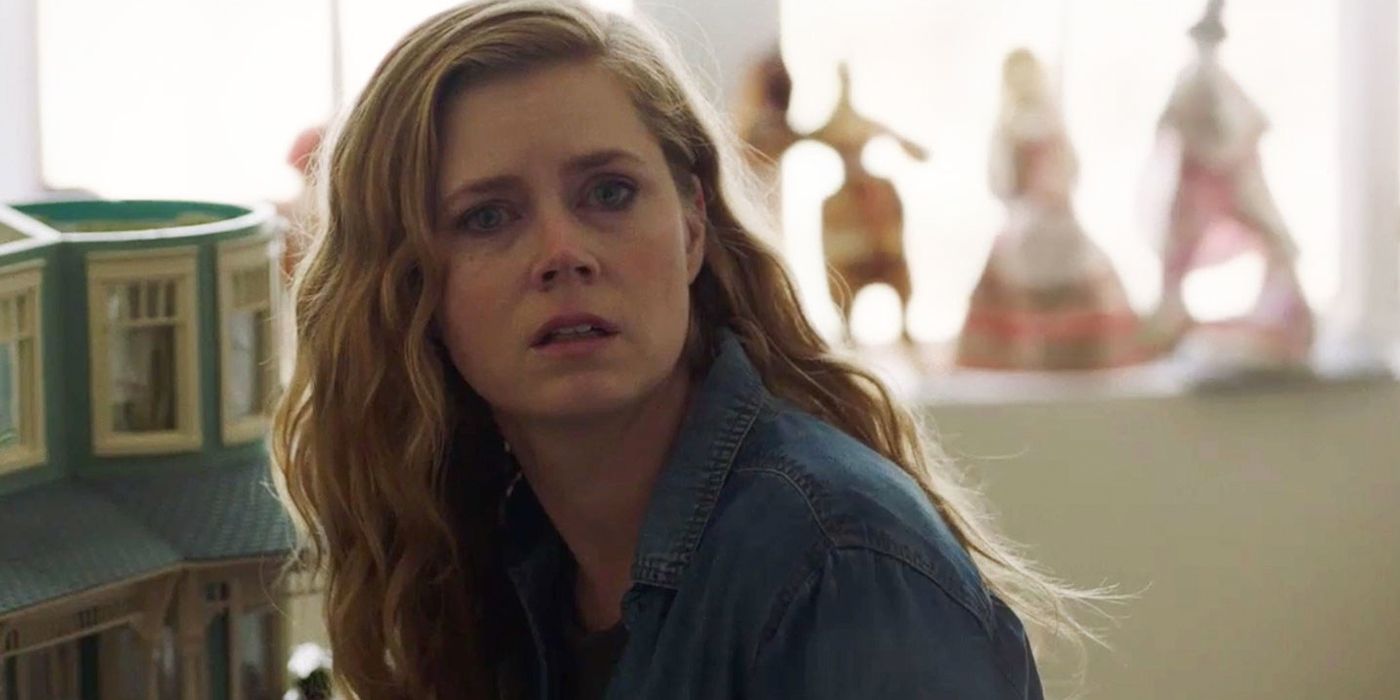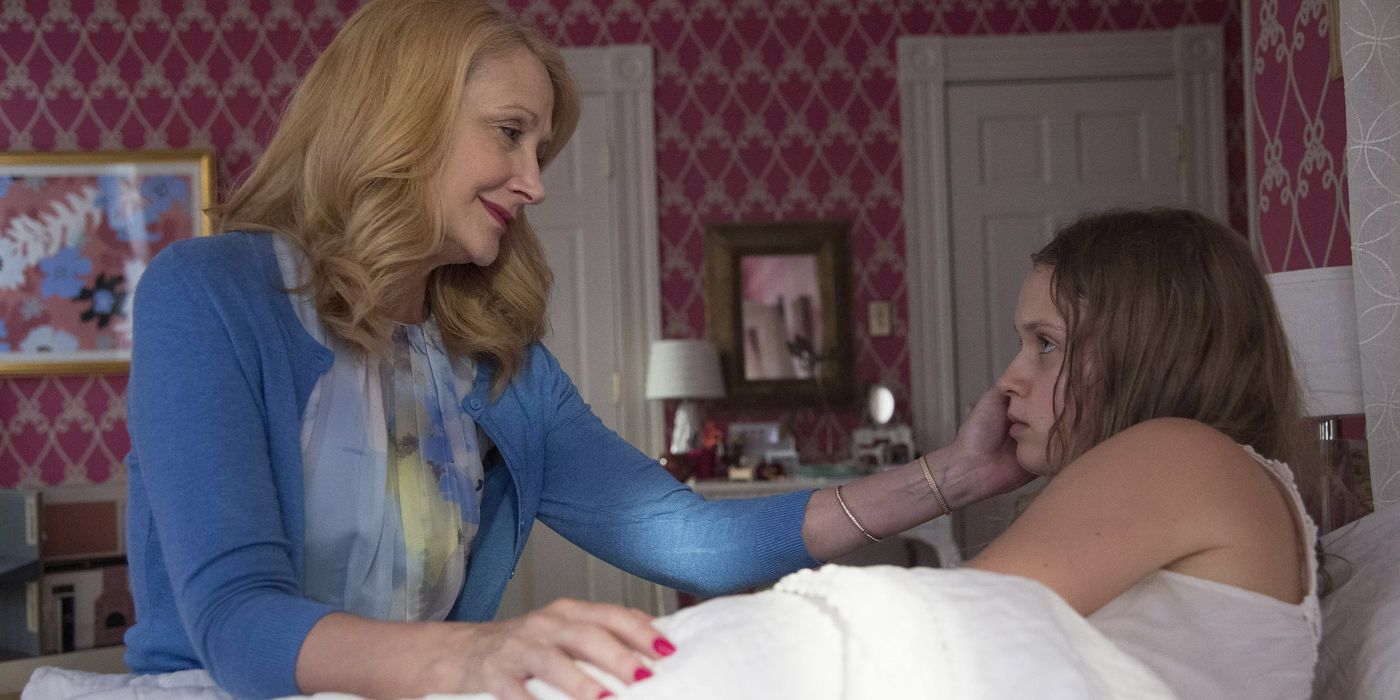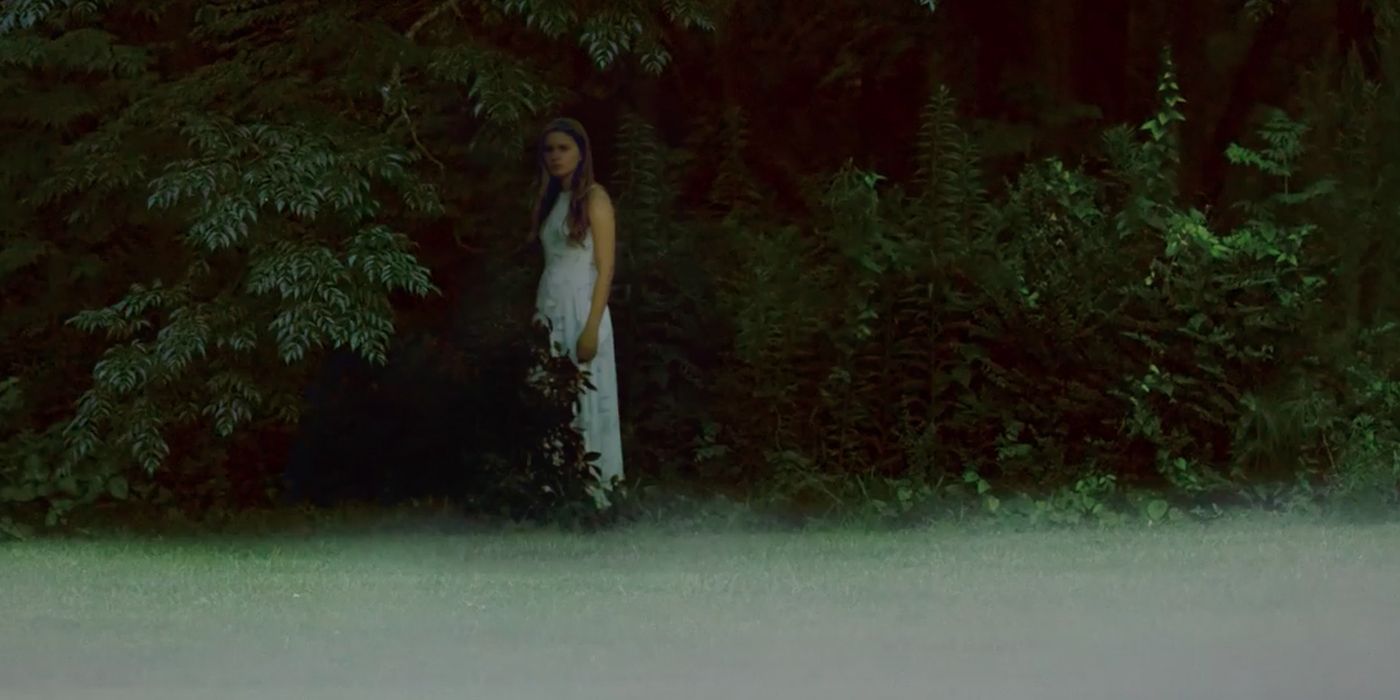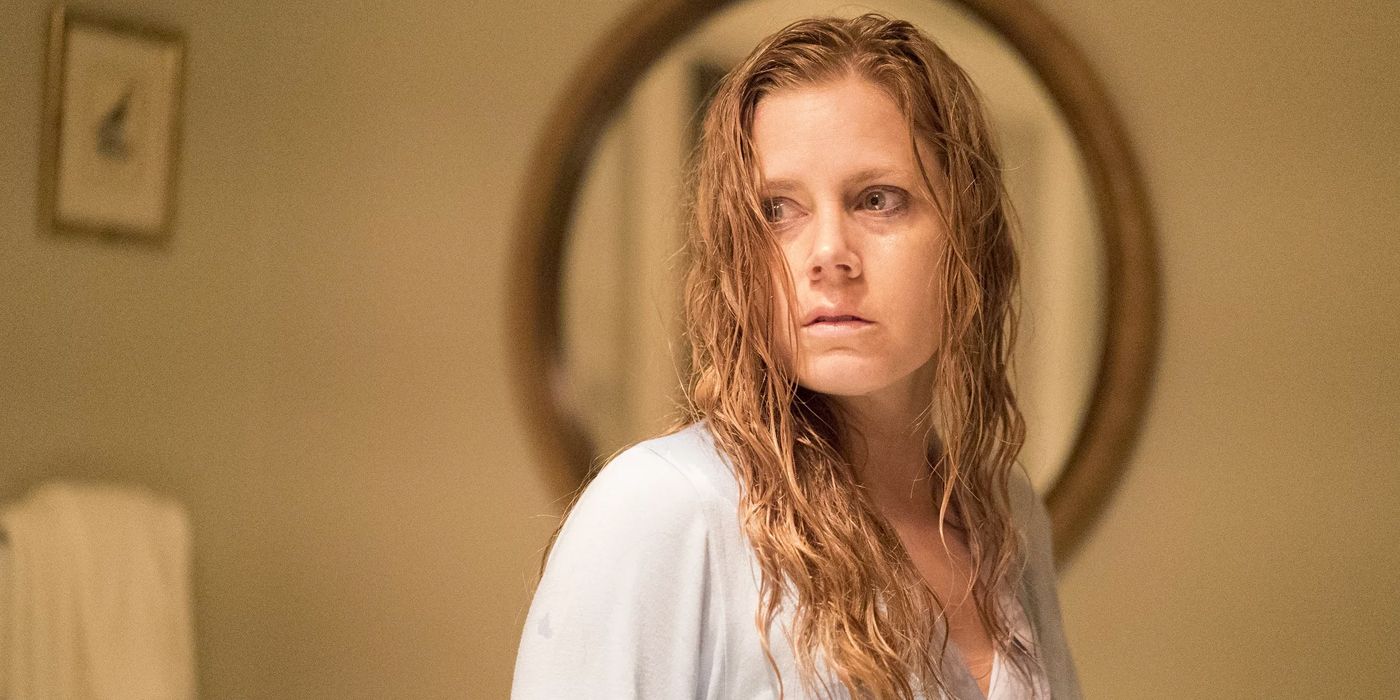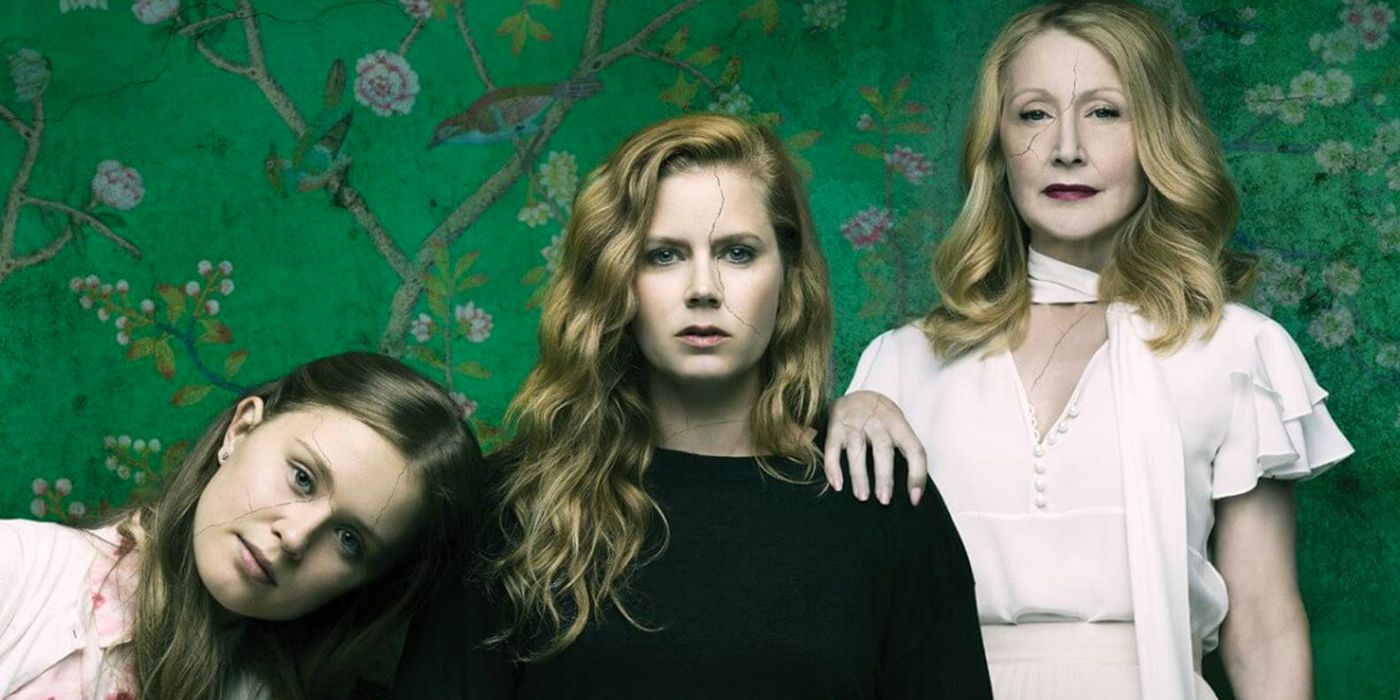MAJOR SPOILERS for Sharp Objects.
HBO's Sharp Objects ends on one final, life-shattering twist - and there's still more reveals to come after the credits. One of 2018's best shows, the Amy Adams-starring miniseries based on Gillian Flynn's 2006 novel has baked the murder mystery in the Missouri sun, delivering something haunting, distressing and full of upsetting inevitability.
The eight-episode series follows Camille Preacher (Amy Adams), an alcoholic journalist who revisits her childhood home of Wind Gap to report on the disappearance and murder of two teenage girls. Once there, she must reunite her domineering mother, Adora (Patricia Clarkson), and forms a close bond with rogueish half-sister Amma (Eliza Scanlen). Outside of the pristine Preacher house, Camille's presence causes ripples through Wind Gap, challenging the small-town investigation and bringing up old secrets in hers and others' pasts.
Related: Sharp Objects Finale Review
The Sharp Objects finale ties together all the big narrative threads and story themes Jean-Marc Vallée raised in the previous seven episodes, delivering something that both makes perfect sense and is wholly upsetting.
- This Page: The Killers And Post-Credits Explained
- Page 2: What Sharp Objects' Ending Really Means
Adora Killed Marian And Poisoned Amma & Camille
Throughout Sharp Objects, the investigation of the girls' murders takes a backseat to the fractured relationship between Camille and Adora. Returning to Wind Gap resurrects a serious animosity between them, one defined by a lack of love but founded on unclear ground. The final two episodes finally explain it, revealing that Adora suffers from Münchausen syndrome by proxy - a mental disorder that makes her desperate to care for others, leading to the sufferer purposely injuring others.
This was the real cause behind the death of Camille's sister Marian years ago; while she was totally unaware, Adora was slowly poisoning her sister. The guilt in the proceeding decades ate away at Camille, the ambiguity over the death haunting her emotionally. The truth finally comes to light thanks to Kansa City detective and Camille's love interest, Richard (Chris Messina), who digs into her past and discovers the family's dark secrets. He passes this onto Camille, who confronts Jackie O'Neill about her requests to find out the truth, during which she reveals Adora had Marian cremated to hide the evidence.
Of course, it's still happening in the present too, with Amma subjected to intense poisoning from before Camille arrived. We've actually had this teased repeatedly but brushed off as Amma's hangovers from repeated drug-infused nights out; only now does to extent and purpose of the red medicine become clear. Camille is poisoned when confronting Adora and taken into her "care", only saved when her editor, Frank Curry, turns up in Wind Gap and pressures the police to investigate.
This twisted happenings led audiences and characters alike to suspect that Adora was also behind the murders of Ann Nash and Natalie Keene; it had been repeatedly stated that the two outcast girls had formed a close bond with her, and so either to fuel her pain or protect Amma, the simple conclusion was that she'd killed them. However, despite bloodied pliers used to remove their teeth found in the house, she wasn't found guilty: the jury couldn't justify her being able to remove the girls' teeth (Richard had suspected Alan but he was never charged). And while their logic was flawed, they were right not to convict.
Amma Was Sharp Objects' Real Killer
The final act of Sharp Objects seems to be something of an epilogue, showing Camille and Amma forming a new life in St Louis - the former starts on the road to recovery and the latter makes new friends and begins to look to the future. However, there's one more twist to go. In the final scene, Camille inspects Amma's dollhouse and finds a tooth in the model, leading to her discovering the replica floor of the ivory bedroom is made of human teeth: Amma was the killer all along. Amma then appears in the doorway, calmly begging, "don't tell mama".
Camille dealt with Adora's abuse by self-inflicted injury, but her younger sister went external, killing both Ann Nash and Natalie Keene, then later new friend Mae. The show leaves the explanation beyond the raw, horrifying fact dangling in the air, an unsettling question, but revisiting previous episodes and leaning a little on Flynn's novel provides the warped motive.
Amma may have developed a tolerance to the poison, but that doesn't mean there was no impact; it shifted her view on reality and perception of pain. She became friends with Ann and Natalie, finding in the outcasts something relatable. However, there was a further skewed morality and desire for attention. The theory that the book leads with is that she became jealous of the attention Adora gave to the girls and brutalized them as revenge (with the help of her skating friends), something that was likewise happening between Camille and Mae, although even then it admits that's just one reading of many. There's a clear power aspect that she and her gang revel in, and the desire to make the dollhouse perfect evidently motivated the teeth-pulling. The real key is that it's a direct result of everything she's been through.
Sharp Objects' Post-Credits Scenes
Camille's discovery isn't the end of Sharp Objects. Like Westworld before it, the HBO show has two post-credits scenes. The first is a quick-cut flash-montage of the three murders: we see shots of Amma and her friends attacking Ann in the woods, bashing Natalie at her brother's apartment, and her strangling Mae alone. These scenes mainly serve to underline the shock audiences have just felt, showing Amma at her violent truth. The nail varnish on Mae's nails as she grabs the chainlink fence also resolves that mystery in Natalie's death.
The final, after-credits shot is the real kicker. After seeing various representations of the Lady in White from Camille's subconscious and dubious witnesses, we finally get the truth: Amma in a white dress inviting her supposed friends to their death. This myth of a figure stealing children haunts Wind Gap, and thanks to Adora's torture of Amma, it's unwittingly become real. The clash of violence and purity is unavoidable, and thanks to some careful fancy dress Sharp Objects draws parallels to Persephone, Queen of the Underworld.
Aside from providing the opportunity for clarity on Sharp Objects' ending, this also marks the first time in the show where we've departed Camille's POV. Throughout the show, everything has been framed as from our protagonist's skewed view of the world, with flashes of buried memories and the blur of alcohol infecting the viewing experience. Now, even if it may be fast, we get something approach truth: and it's even worse than we'd thought.
Page 2 of 2: What Sharp Objects' Ending Really Means
What Happens After Sharp Objects' Ending In The Book
While the core of Sharp Objects' twist is the same as the book, the two tellings are very different in how they handle it: while the Sharp Objects show ends with Camille discovering Amma's secret, the novel goes further, showing the handling and impact of Amma's crimes.
After Camille's discovery - which is powered by the discovering of Amma's schoolmate dead - and her sister is convicted and found guilty, although naturally tried as a minor so may be free when she's older. Camille relapses after having her world flipped (again), cutting her back and heading back towards alcohol. She's saved by Curry, who takes her in and finally gives her the care she needs and craves.
Most of the show's changes center on the decision to end on the Amma twist - everything that happens can't be shown by the constraints of narrative as a result - which immediately makes for something more unsettling and less explained; most of the details of the twist are delivered in quick flashes during the credits. The bigger impact, though, is on Camille's recovery. The book is more pointed on her finally finding a family, which is thematically sound but rather idealistic; HBO's Sharp Objects has that same clarity come from a cumulative effect of resolution and compassion, a much more grounded take.
What Sharp Objects' Ending Really Means
Sharp Objects is an incredibly focused miniseries, knowing exactly what it's trying to explore and confident in a degree of disconcerting ambiguity. Chiefly, it's about the scars of the past and how they slowly manifest in both physical and psychological ways: Camille is affected emotionally by her upbringing in Wind Gap, something she brings to the surface through her self-harm; Amma is physically tortured by Adora and breaks mentally, yet on the outside appears youthful and "normal". The show's final conversation has Mae's mother comment on the only enviable part of being a teenager being the skin in the same breath as dismissing a deadly fight as a small disagreement, nodding that the real cost of any upbringing comes later.
It's a twist on the age-old nature vs. nurture debate. Camille enters still shaped by her past in Wind Gap and ends with the lingering threat she's inheriting Münchausen syndrome by proxy - is her kindness genuine or simply a mental block enabling her to hurt others? Wind Gap is every sleepy town with a toxic core that a lucky few escaped, yet the real horror lies in the family that created Camille's tragedy; everything that happened with other Wind Gap children starts at the damage in the Preacher house.
And it's here we get something approaching a happy resolution. In the epilogue, Camille gets past this past by understanding and acceptance in the life she has now. Of course, it's thrown for a loop by Amma, showing that some things are truly inescapable, but the decision to cut out her final descent from the book leaves the ultimate conclusion up to the reader.
The key distinction in the presentation of these themes is Gillian Flynn's exploration of the perception of women. From the very start, the suggestion that the killer could be anything other than a man is dismissed based on perceived strength and the paradoxical notion of feminine rage. Later, the final time we see Amma's friends, the real killers, has them reminded Chief Vickery that women can be dangerous drivers too. Sharp Objects is constantly dismissing women with a sheen of unassuming positivity, and while to challenge that is aggressive the series ultimately shows that's necessary; in the Preacher house alone, Adora and Amma are killers while Alan's a pawn, and the female stranglehold can be found all around. This similar idea was explored very differently in Gone Girl, where again Flynn tried to highlight skewed gender perceptions through an extreme story.
-
Sharp Objects is a show that begs rewatch. It carefully seeds clues in plain sight, using only its psychologically broken protagonist to obscure them. Looking back with a sense of clarity, suddenly the truth of the darkness becomes clear. And that experience coming out the other end may be the best emotive conclusion it could have offered.

